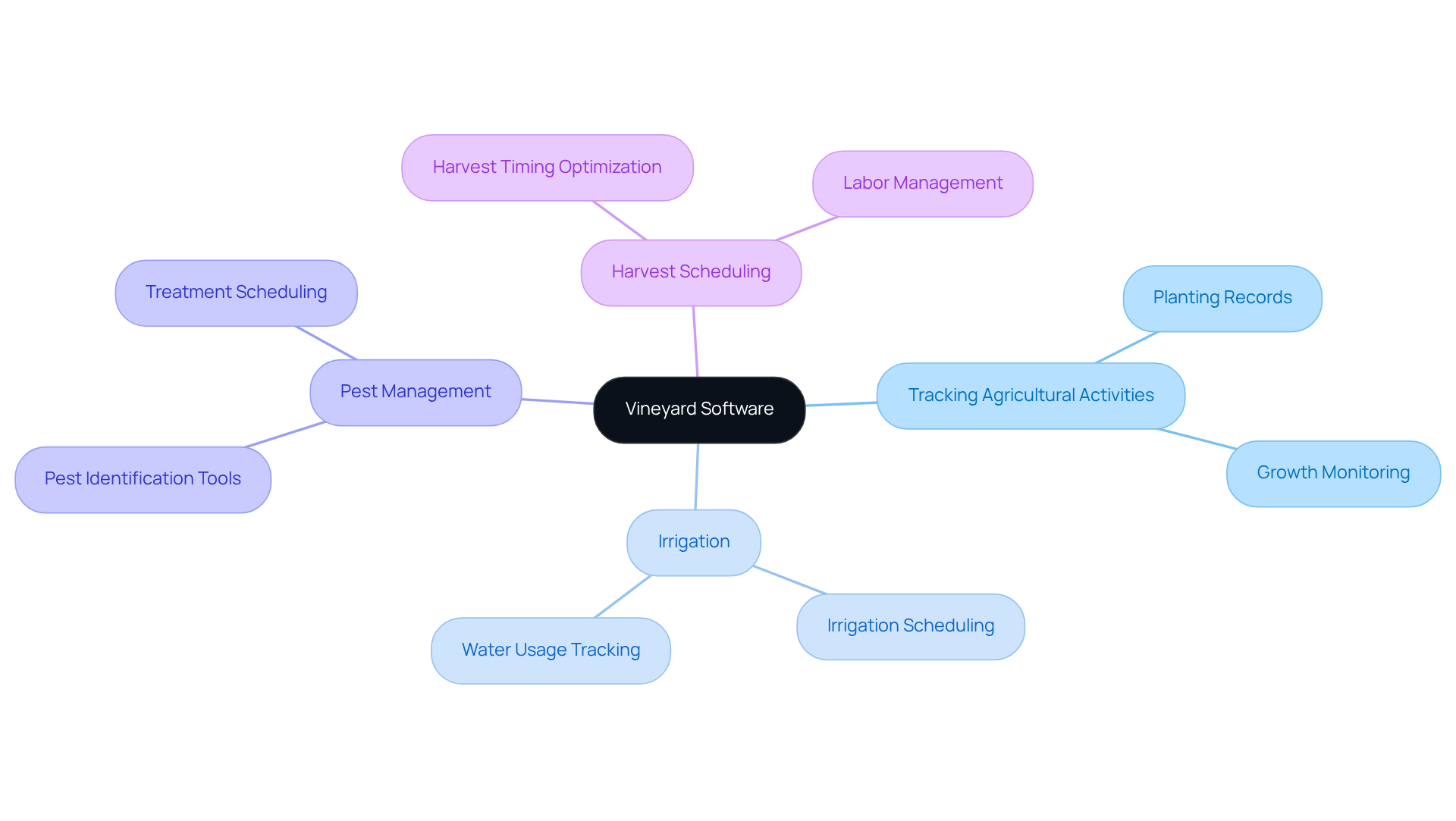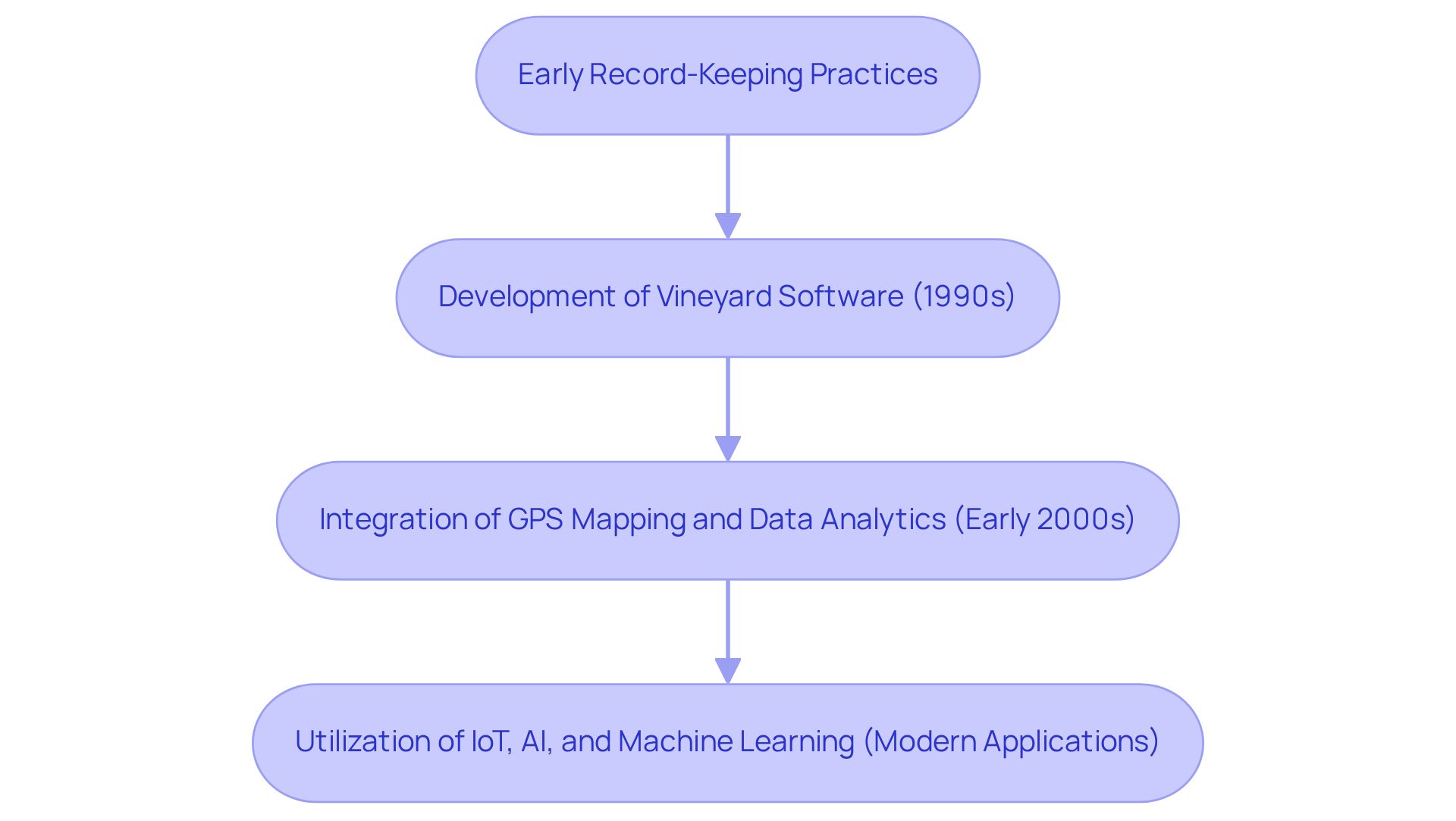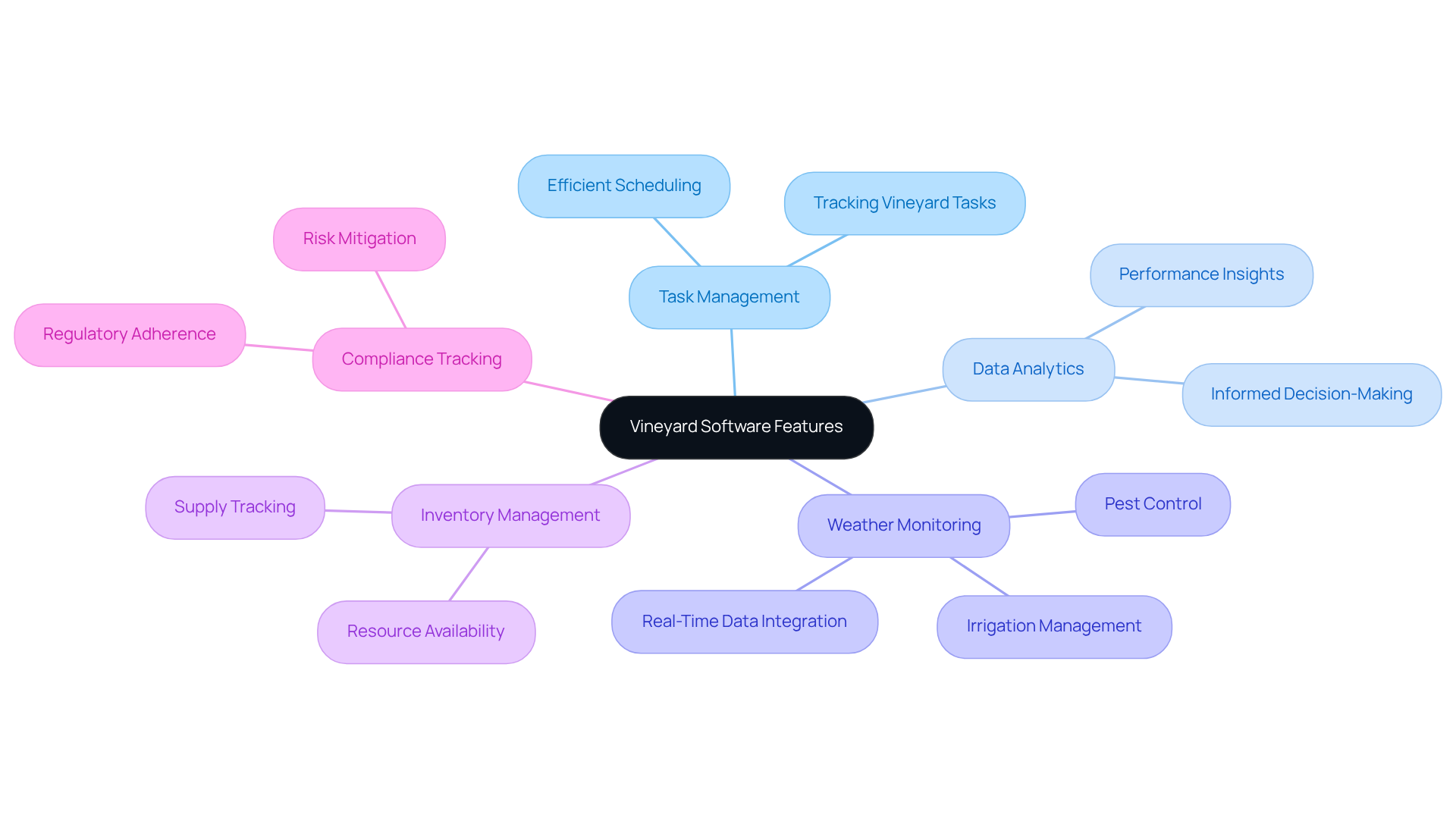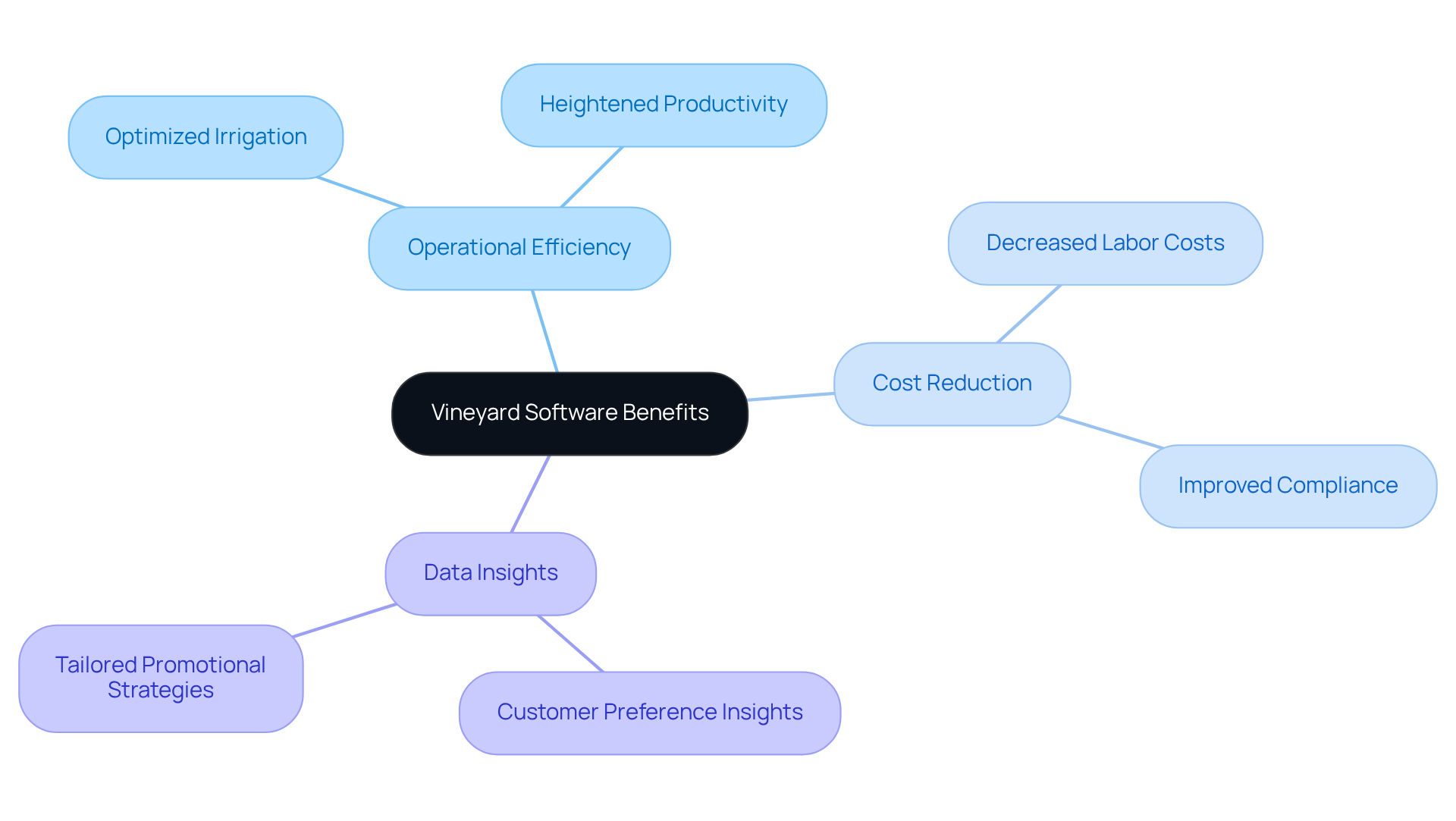Overview
Vineyard software stands as a pivotal application tailored to elevate the management of grape-growing operations. By offering robust features such as:
- Task management
- Data analytics
- Weather monitoring
- Compliance tracking
it empowers vineyard managers to optimize their processes. These capabilities not only streamline operations but also enhance productivity, leading to informed decision-making. Ultimately, this results in superior grape quality and more efficient winery operations. In an industry where precision and efficiency are paramount, adopting vineyard software is not just beneficial—it's essential for staying competitive.
Introduction
Vineyard software has emerged as a transformative tool for wine producers, revolutionizing the management of grape-growing operations. By harnessing advanced technology, these applications streamline essential processes such as irrigation and pest management while providing critical data insights that enhance both productivity and grape quality.
In an increasingly competitive wine industry, the question arises: how can vineyard software elevate a winery's operations and secure its success in the market?
Define Vineyard Software and Its Core Functions
Vineyard software represents tailored to empower viticulturists in the comprehensive management of grape-growing operations. These applications primarily focus on essential functions such as:
- Tracking agricultural activities, including planting
- Irrigation
- Pest management
- Harvest scheduling
By leveraging vineyard software, vineyards can streamline processes, enhance productivity, and make informed decisions through data-driven insights. Furthermore, by integrating various operational components, winery management tools play a crucial role in maintaining optimal grape quality and operational efficiency. This ultimately leads to superior wine production outcomes. Are you ready to elevate your vineyard operations?

Trace the Evolution of Vineyard Software in Winery Management
The evolution of winery applications is rooted in the fundamental record-keeping practices of early grape growers. As the wine industry flourished, the complexity of grape cultivation management led to the development of increasingly sophisticated vineyard software. By the early 2000s, vineyard software for managing grape cultivation began to integrate features such as GPS mapping and data analytics, which enabled more precise tracking of growing conditions. Today, vineyard software utilizes IoT devices, AI, and machine learning to provide into vine health. This empowers producers to make informed decisions that enhance grape quality and yield, ultimately driving success in the competitive wine market.

Identify Key Features and Components of Vineyard Software
For modern wine producers, is essential as it provides key features that significantly enhance operational efficiency and decision-making.
- Task Management enables users to efficiently schedule and track essential vineyard tasks such as pruning, fertilizing, and harvesting.
- Data Analytics offers valuable insights into agricultural performance through advanced data visualization and reporting tools, empowering producers to make informed decisions.
- Weather Monitoring integrates real-time weather data, allowing for effective management of irrigation and pest control, which is crucial for maintaining crop health.
- Inventory Management ensures that supplies and equipment are meticulously tracked, guaranteeing that resources are readily available when needed.
- Compliance Tracking assists wine producers in adhering to regulatory requirements by maintaining precise records of agricultural practices, thereby mitigating risks associated with non-compliance.
Collectively, these features not only enhance operational efficiency but also support better decision-making in grape cultivation management, establishing vineyard software as an invaluable asset for any wine producer.

Explore Practical Applications and Benefits of Vineyard Software
The practical applications of vineyard software are vast, significantly enhancing operational efficiency and grape quality—both crucial for family-owned wine producers. For instance, vineyards can optimize irrigation schedules through real-time weather data, resulting in reduced water usage and improved sustainability. By closely monitoring grape-growing operations, producers can identify optimal methods that lead to increased yields and superior grape quality.
The use of vineyard software yields numerous benefits, including:
- Heightened productivity
- Decreased labor costs
- Improved compliance with agricultural regulations
Moreover, leveraging data analysis allows vineyards to gain insights into , enabling them to tailor their products and promotional strategies effectively. By aligning these insights with Enocap's direct-to-consumer strategies and capital advisory services, wineries can successfully convert casual buyers into loyal club members, unlocking growth opportunities through customized solutions.

Conclusion
Vineyard software serves as a transformative tool for wineries, enabling them to effectively manage their grape-growing operations through advanced technology and data-driven insights. By integrating essential functions such as task management, data analytics, and weather monitoring, vineyard software not only streamlines processes but also enhances productivity and grape quality, ultimately leading to superior wine production outcomes.
The evolution of vineyard software has progressed from basic record-keeping to sophisticated applications utilizing IoT and AI technologies. Modern vineyard software features—including inventory management and compliance tracking—demonstrate its critical role in optimizing operational efficiency and supporting informed decision-making. Furthermore, the practical applications of this software reveal its capacity to improve sustainability, reduce costs, and align production with customer preferences.
The significance of vineyard software extends beyond mere operational enhancements; it represents a vital investment in the future of winemaking. As the wine industry continues to evolve, embracing these advanced tools empowers producers to thrive in a competitive market. Wineries are encouraged to leverage vineyard software not just as a means of management, but as a strategic partner in achieving long-term success and cultivating a loyal customer base.
Frequently Asked Questions
What is vineyard software?
Vineyard software refers to advanced applications designed to assist viticulturists in managing grape-growing operations effectively.
What are the core functions of vineyard software?
The core functions of vineyard software include tracking agricultural activities such as planting, irrigation, pest management, and harvest scheduling.
How does vineyard software benefit vineyards?
Vineyard software helps streamline processes, enhance productivity, and enables informed decision-making through data-driven insights.
What role do winery management tools play in vineyard operations?
Winery management tools integrate various operational components to maintain optimal grape quality and operational efficiency, ultimately leading to superior wine production outcomes.




